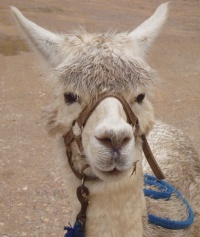 Alpacas are a native and domesticated animal from South America. They are hardy and adaptable to a wide range of conditions, being found in the tropics of North Queensland, south to Tasmania and across the continent to Western Australia.
Alpacas are a native and domesticated animal from South America. They are hardy and adaptable to a wide range of conditions, being found in the tropics of North Queensland, south to Tasmania and across the continent to Western Australia.
In 1998 there were around 14-15,000 Alpacas in Australia.
Alpacas are bred primarily for their superb silky fine fleece which is strong and warm. The fibre comes in some 12 different colours. Breading is presently being directed to produce strong, uniform and fine (recommended 25 microns) fleece. The main uses of the fleece in Australia include: clothing, and doona filling. Alpacas are also popular in farm tourism enterprises. Australia is strategically placed to supply the Japanese market, which is the world's largest.
They can be farmed on small acreages with low establishment costs, and there is no requirement for special facilities and elaborate fencing as they do not 'work' fence lines nor do they jump or push fences. They have padded feet, and tend to be light grazers, making them less likely to damage pasture and soils than traditional grazing animals, such as sheep and cattle. They do well on lower quality hay and pasture than traditional grazers in Australia.
Alpacas are easy to care for as they are generally disease resistant (only known to get Johne's disease and facial eczema), and generally do not suffer from fly-strike and foot rot. In cold rainy areas they do require shelter.
Females are joined at 15 months old. Gestation period is 111/2 months, and rejoining can be within 2 weeks. Alpacas can live 15-25 years, and can weigh up to 70 kg.
LLAMAS
Llamas are closely related to alpacas, but larger, and do not have the same quality of fibre. Llamas are more commonly kept for meat or as a pack animal. The males can carry weights up to 25% of their body weight. Like the Alpacas they are very gentle, intelligent, and easily trained animals. There are two types of Llamas. Most are non-woolly llamas which have a coarse, short fibre. The others (Woolly Llamas) have a long fibre, which is generally soft, but coarser than alpaca fibre. They require similar conditions to Alpacas. The females can give birth to one cria (baby llama) per year. llamas have an expected life span of 20-25 years.
For More Information:
Magazine: Alpacas Australia
381 Tooronga Rd, Hawthorn East, Victoria, 3123 Australia.
Australian Alpaca Assoc. Inc.
Suite 1, 818 Whitehorse Rd, Box Hill, Victoria 3128.
Postal: Private Bag 4200, Box Hill, Victoria, 3128.
Ph: (03) 9899 1099, Fax: (03) 9899 1055.
Llama Association Of Australia Inc.
RSD E1328 Mc Farlanes Lane, Mt Egerton, Victoria, 3352.
Phone/Fax:
(03) 5368 9616
Recommended Courses
A good starting point for any animal farming, is a course in Animal Husbandry I (click to see details) followed by Animal Husbandry II and Animal Husbandry III.
It would also be useful to study Farm Management